One of the things I enjoy about visiting my father in Charleston, S.C., is you are always walking distance from stunning furniture from all over the world and across several centuries.
I spent this morning collecting images, details and dimensions for my next book and stumbled into a store I’d never been in before. It specializes in furniture from the West and East Indies – specifically campaign furniture.
Ever since I was a kid, I’ve loved campaign furniture – my grandparents had several pieces – and I’ve always wondered why it wasn’t a popular style among woodworkers. It’s manly, simple, robust and (generally) well proportioned.
The store’s owner has been importing it into Charleston for about 15 years and showed me a lot of construction details I hadn’t yet considered, such as how examples that used teak as a secondary wood were much more likely to be the real deal. Teak is quite bug-resistant. Dovetail joinery that didn’t rely on hide glue was a good thing because of the wetness, heat and bugs that would eat the hide glue.
If someone else doesn’t pick up this idea and run with it, campaign furniture might be a book in my future. Earlier this year I proposed a campaign chest project to Popular Woodworking Magazine – I haven’t gotten a “yes” or “no” yet. Perhaps these photos will sway Megan.
— Christopher Schwarz


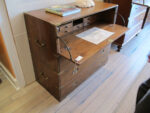
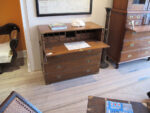
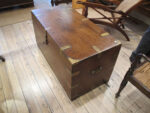
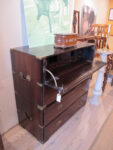
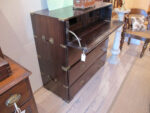
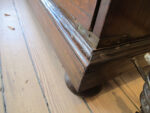
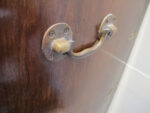
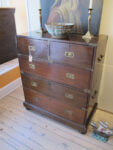
I would -love- a book on this! While I’m not very familiar with campaign furniture in general, it’s intuitively clear how sturdy, clever, and efficient these pieces are. I am especially smitten by that first desk you have pictured; the tiny drawers which might violate your toolchest rules seem much more appropriate here to organize stationery goods and such. The stacking chest concept is also fantastic. Almost a shame to have these pieces in a home where they won’t be moved around.
Right…to quote Shrub, I’m the decider.
You get ten extra points for this.
Please!!!!!!!!!!!
It would look great on the front cover!!!
I like campaign-style furniture, too. My son had a storebought bedroom set, and I built a wastebox in the campaign style to match it. He still owns the wastebox, though the other stuff is long gone.
Another “style”, functionally similar, is the wardrobe my friend Louis has. It’s a big piece, almost 8 feet tall, but will come apart into transportable pieces. It’s from Texas, about 1850, when houses were taxed by the room, and a closet counted as a room. I’d like to see such a wardrobe as a project.
There is a book out there but something with measured drawings, an American focus and how to’s would be a boone. As a reenactor I would very much appericate it.
Leon
British Campaign Furniture: Elegance Under Canvas, 1740-1914 [Hardcover]
I am presently building a Micro House and the Campaign Chest in the first image is exactly the type of furniture I want to build for it. Could you give me the rough dimensions of it?
It’s about 38″ to 40″ high. About 18″ – 20″ deep. It’s a pretty standard chest dimension.
Chris –
Is that drop-front hardware the same type used on chests, but reversed so that the mortised part is on top, or is that a different type of hardware?
Beautiful pictures by the way.
Jonathan
===================================
I think this style is superb, and Megan has got to let you do the campaign chest project.
In the meantime, what stops the top piece of the writing desk from sliding around on the lower piece?
Paul.
Sign me up for an advance sale….
Wow! A book–or even an article or two–on campaign furniture would be outstanding! I believe that the book Leon referred to below his signature, “British Campaign Furniture: Elegance Under Canvas, 1740-1914” by Nicholas A. Brawer, is the ONLY book on the subject. It’s out of print and the few copies to be found on Amazon or eBay are very expensive. And in this mobile society we live in it is a wonder that this ground hasn’t been covered before. Perhaps it is because some of the components–brass hardware and exotic woods like camphor wood and teak–make these projects expensive to reproduce.
how about a reprint of this book through lost art, or F+W media? there’s no way I’d pay $375 for a book. The high is $675! (ebay or amazon). Crazy! When a out of print book is commanding that much money, I’d say its prime time for a reprint.
The only other coverage of American Campaign furniture I am familiar with is an article in the old/defunct woodworking magazine about about a shop called Logan creek designs near Winchester VA I think. Some of his furniture was used as props in the movie “Gods and Generals”.
There’s also a neat little book called “Civil War Woodworking”, that has other projects for the period, all potentially useful for re-enactors. It has a few simple items.
Hi Chris
I do like the clean lines of this style.
Over the past few months I have been documenting a build of two military/campaign chests on my website: http://www.inthewoodshop.com/Furniture/index.html
Scroll down to “Entertainment Centre based on Military (Campaign) Chests”. There are 9 entries to date. The first entry has a little of the background to this furniture.
Regards from Perth
Derek
You are a better man that I am Gunga Din.
When I was about 13, I got hold of my Grandma’s old steamer trunk—the kind they restore now days, but then Grandma figured it was junk. My notion of restoration was colored by Rudyard Kipling. By the time I was finished that old trunk had the Arms of the Bengal Lancers on it. I took up drinking tea.
King of the Kyber Rifles
Wee Wille Winki
Rorke’s Drift
Snows of Kilimanjaro
“Doctor Livingston, I presume”
Captain Sir Richard Francis Burton
I kept looking for campaign furniture over the years but all I’ve seen made has been junk. Time for the real thing.
I here that at Gencon, the big fantasy gaming convention, the most popular identity was Steam Punk–vaguely Captain Nemo, Lord Greystoke, Phineas Fogg, Sherlock Holmes. It looks like the current generation of young adults are looking for order, some boundaries. They might not be able to fathom or live by Victorian moral and esthetic sensibilities but I get the impression they are romantically idealizing them. Campaign furniture could be a trend.
Yours Aye
Morgan
Chris,
Were you able to resist timing those screws?
Love the campaign style! I’d buy a book on the subject, and would enjoy articles in PW as well. A history of campaign furniture would be nice as well (in the book, alluded to in the article perhaps?). One of my favorite novel series is known in the US as The Camulod Chronicles by Jack Whyte. In this cracking good historically based retelling of the Arthur legend, Merlyn is a Roman-trained soldier and mention is made in several places of Roman-style campaign furniture that his father before him took when his legion was on the move. Mr Whyte’s goal in the series was to figure out how the real Arthur could have come to power inside the historical context of 3rd century Britain. I know this is more than slightly off-topic, but the history of this furniture would make a great addition to any book/article on the subject. We forget these days how advanced the Romans really were in their day.
+1 on Megan letting you do the campaign chest article, I’d love to read it. You mention teak as a secondary wood, any idea what the primary wood species are in the examples you posted?
British Campaign Furniture, Elegance under Canvas, 1740-1914 by Nicholas A. Brawer, 2001 ISBN 0-8109-5711-6.
i have this volume in my collection, see page 124 for a similar 2 part Military Chest.
300-600 bux for a ten year old book. Wow. Just wow.
Seriously. The rights to this book must be tied up in litigation or some bureaucratic hell. I can’t imagine why it hasn’t been reprinted otherwise.
there were some bamboo rod building books that had gone out of print for a while, and were reselling for similar prices (well – maybe $250-400). Fortunately they were reprinted again not long ago. I doubt its litigation – just a limited supply and a publisher that is maybe no longer in business or struggling.
its worse than Harry Abrams being out of business – they were bought out by a French pucblisher!! That’s probably why this book will never see another run.
I have a book in my library called “Civil War Woodworking” by A.J. Hamler, Linden Publishing, Fresno, CA. (2009). It has a number of desks, camp chairs, benches, even a bucksaw. One of the field desks is on my list of things to build. I would recommend it. Amazon has it at $16.47 for paper, $9.99 Kindle.
Dan Ballard
I, too, lament the fact that the only easily found source material is not easily affordable. But I’m interested. What was the store?
And to Megan…
7 years ago, I was a beginning wood worker, who had just taken my first class. I built a pair of stacking chests of drawers to use as a dresser as my first real project, after finding a picture of a campaign chest like this somewhere. The virtues as I see it for such an article:
The history of campaign furniture makes for good reading. As I understood it, it was high style furniture built for the open seas, ultimately destined for British camps in India, so the occupying gentry could maintain the veneer of civilized manners and routines. and built to be broken down. Not just stacking dressers, either, but full size dining tables that flat packed into small crates, chairs with carved legs that also broke down or folded, that kind of thing. It’s somewhere in the spectrum between Japanese tansu, and Chinese break-down furniture… but with a distinct historical and design sense.
The segue into more modern terms… it’s made to be movable. High boys and secretaries are all fine and good for those who will never drive another U-Haul truck again. When I built my dresser, I’d moved at least every year or two for a decade, and I was tired of replacing particle board garbage every freakin’ time. I just wanted something I could throw into my pickup and have it be OK.
AND, this was a good project that was within my skill level. Dovetailed box holding more dovetailed boxes, with metal corner pieces screwed into place… more advanced than drywall screws, and good practice for new guys. And DT’ing a full carcase like this is a different animal than a drawer.
The joy of such a project as a point of departure is that a) It can be as simple as you want (boxes with drawers) or as complicated as you want. (drop-front desk built into a drawer… or as a later project to replace a drawer) Dovetails or box-joints, (Or pinned box joints) fancy lumber or not. Simple knobs, or flush ring pulls. And built out of whatever… I built mine out of laminated pine from a home center, with plain brass knobs and leather (foot locker style) strap handles on the sides. The reinforcing brackets on the corners were simple L-straps, also from the home center.
Lacking ornamentation, and designed with metal reinforcements, it’s another beginner-friendly project, but it’s not Shaker! (I like shaker. But there’s a lot of it out there, and a lot of bad shaker out there, too, and it’s all been done before.) And mounting flush hardware is worth another article on its own. (For instance, it’s worth noting that the 2″ diameter flush ring pulls are actually 1 15/16″ in diameter.)
As a design exercise, this is an interesting one, because the focus isn’t really on the wood grain, it’s on the geometrical regularity of the brass hardware.
And lastly, let’s face it… sponsors love to sell hardware. And these have a lot of hardware.
Hear, hear! Well said, James! (and thanks to Megan!) This is the kind of stuff I subscribe for.
James,
I, for one, am all for a campaign chest in the magazine — and I’ll fully support it at our next manuscript meeting (where majority opinion wins).
Somewhat related – how about an article on your favorite places to visit for antique furniture? Poking around antique stores serves as the genesis for a huge source of my random inspirational moments, and I almost always come away with some new nugget after any visit, but the truly good stores seem to be few and far between.
And Megan – Shrub? Tsk, tsk.
My father lives in Downtown Charleston, SC too. His wife collects furniture from the American Empire period. I thought I knew alot about furniture styles, but I have never heard of campaign furniture. It’s good to learn new things!
yaakov….
The topic of “takedown” furniture in general is interesting. Most of the furniture made in Newport in the 18th century was made for export, mostly to the West Indies. Newport high chests made by the Townsend-Goddard families had cabriole legs that were removable, and the top and bottom halves of the chests came apart.
I know it’s not campaign furniture, but the ability to make things portable was very important.
Chris has this uncanny knack. With people on the move so much, this style is at once clever and fashionable. So many people are on a lengthy campaign, from one dwelling to the next, across town and across the country, from tiny first apartment to starter home and back to Mom’s basement. Campaign chests and chairs, along with things like the stackable Jefferson bookcases would provide a highly usable basic set of furniture for the large nomadic demographic of our society these days. There’s the book. Or the NYC furniture store.
I travel nearly every day for work. I’ve been considering making a mobile workstation that would be carry-on sized and fold out my laptop and all the peripherals and only have to plug in one plug when I’m on the go. Now I see the perfect style to apply for these “campaigns.”
Personally, I would prefer to see an article that would bring together the theory and design points of the style rather than a specific project with construction details. In fact I would like to see that as a regular feature: History and specifics of lesser known furniture styles.
Jeremy,
A column such as that would require considerable resources from people who spend their lives in those details – people like John Kirk and Chuck Bender come to mind.
And… oh wait, I’m not editor anymore.
Chris
OMG that close-up of the handle has me running to clock the screws on my dresser. Horrors! And on campaign furniture no less. Surely some Capt Sobel (Band of Brothers) type would have written the owner up.
I hope you pointed it out to the antiques dealer.
so what about perusing photographs from the civil war (or war of nothern aggression), especially those taken in encampments – I’ll bet there are also many other exmaples to be found there. that ought to be enough for inspiration.
Chris,
I’ve seen a lot of campaign furniture and while I also find it solid and functional I have to say it also evokes something unpleasant. Furniture is as much about how it makes you feel, what it represents, as about techniques of construction – as an aesthetic anarchist I wonder if you might agree on that. What I see in campaign furniture is rampant imperialism, military objectives, the bureaucracy behind an army on the march. This is the furniture of the brass hats sending canon fodder to their deaths in the cause of subordinating people who are different.
While I appreciate your need to find new subjects for books, the furniture style of war strikes me as an uncomfortable choice. If it’s the furniture of the road you’re looking for I’d have thought gypsy style was more your cup of tea.
Best regards, Rob
What a ray of sunshine…
Rob,
Campaign-style furniture was not just for the British officer. It was also quite popular at home for more than 100 years, where it was valued for both its portability and versatility. Likewise, the American military developed its own style of furniture based on English models as well. So the history of the furniture is more complex than simply labeling it an instrument of Imperialism.
In any case, I think it’s folly to reject cultural artifacts simply because they were developed in response to wartime. The Willys Jeep, the Volkswagen Beetle and the Mitsubishi were all wartime products that have been adopted commercially in times of peace.
Campaign furniture required excellent craftsmanship, superior joinery and innovative design to survive. Add to that the fact that it is a style that eschews adornment, and I think that it’s something that could be popular again and used effectively by peace-loving people like myself.
Thanks for the comment. All the best.
Hear-Hear